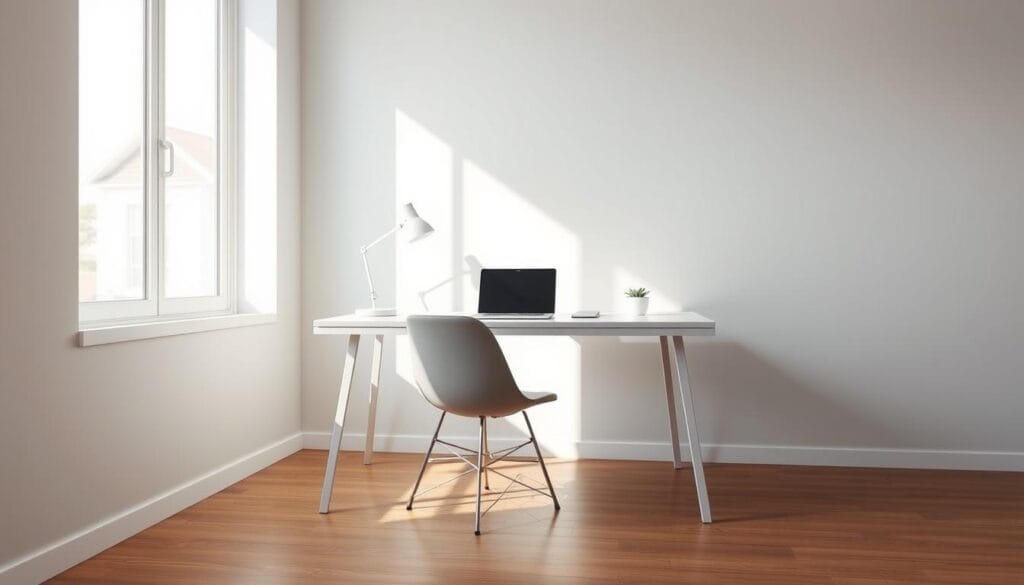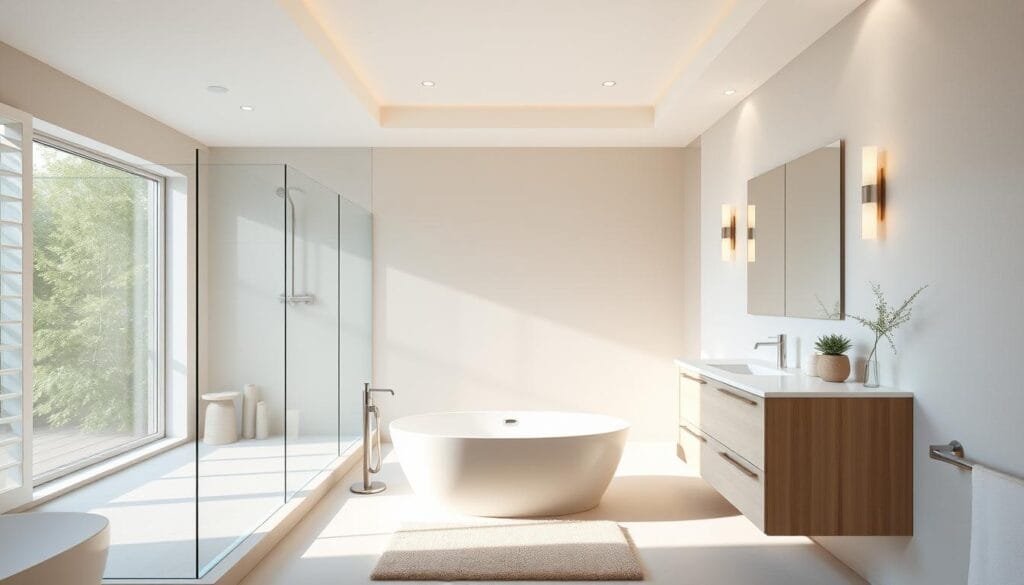Imagine walking into a room that instantly makes you feel calm. The space is open, neat, and everything is in its spot. Sunlight shines through big windows, creating soft shadows on light wood floors.
There’s a serene simplicity, a choice that turns chaos into peace. This is the effect of minimalist home interior design.
Minimalism isn’t just about removing things. It’s about creating a space where everything has a purpose. Think about your own home. Imagine a minimalist living room that invites calm, or simple decor that motivates you daily. Let’s see how to make this happen in your space!
Starting from zero or tweaking a few things? Our journey into minimalist design offers practical tips. Plus, we’ll share inspiring ideas to create your dream home. From basics to selecting the best furniture and decor, we’re here to help. Get ready to enjoy the beauty of simplicity and turn your home into a restful retreat.
Understanding Minimalist Interior Design Principles
Embracing minimalist approach means loving simplicity and the value of each element. When we adopt minimalist interior ideas, we look into the main principles. These make the style refreshing and good for the planet.
The Philosophy Behind Minimalism
Minimalist interior design comes from the idea of keeping only what’s necessary. This idea is inspired by Japan’s Zen Buddhism and Scandinavian design. These inspirations help create spaces without too much stuff.
Spaces with minimalism can make stress go down by 40%. This is because there’s less clutter to see. This shows why many people feel calmer in such places. A minimalist space is not just nice to look at; it’s a peaceful place that brings clarity.
Key Characteristics of Minimalism
Modern minimalist design features clean lines and neutral colors. It combines beauty with usefulness. You’ll see simple forms, a palette of calm colors, and open spaces that let in light.
About 75% of minimalist spaces use calm colors like white, beige, and grey. This helps make a place feel open and peaceful. Adding different textures and colors stops it from feeling empty. Half of the designers suggest this.
Furniture in these spaces is more about being useful than looking fancy. Around 65% of minimalist furniture is made to be practical. Choosing pieces carefully makes the room feel more peaceful. Every item, from sofas to lamps, adds to the calm feeling.
To learn more about these principles, and to see top designers’ work, check out these insightful tips.
Benefits of Minimalist Home Design
Going minimalist in your home isn’t just about looks. It also adds many benefits to living better. You’ll use space better and feel less stressed. These positive changes come from adopting minimalist design.
Enhanced Space Utilization
One big plus of minimalist decor is making your home feel bigger and more open. By keeping only what’s essential, rooms seem more spacious. Furniture that serves more than one purpose is key here. It lets small areas be used in many ways. Research shows that such smart furniture can make your space 25% more effective. This means you really get the most from every inch of your home.
Reduced Clutter and Stress
Less clutter is a big part of minimalism, and it really cuts down stress. Studies show clutter can make stress shoot up by 30%. But minimalist rooms, with fewer things and cleaner surfaces, make for a calm and focused space. This peaceful vibe can also make you 20% more productive. That’s something that can truly improve how you live each day.
Increased Aesthetic Appeal
The beauty of minimalist interiors is clear. With less around, you notice the elegance of simplicity more. These spaces are also easier to keep clean, often requiring half the work.
Homes with a minimalist design are seen as 30% more appealing than cluttered ones. The simple yet timeless look of minimalist decor means your home stays in style. It brings lasting value and charm to your space.
Choosing minimalism not only gives you a stylish home but also practical daily benefits. Simplifying your space brings clarity and happiness. This makes for a more peaceful and enjoyable home life.
Color Schemes for a Minimalist Look
Thinking about a peaceful space, color is key. For a minimalist bedroom, use few colors for calm and simplicity. Shades of white, beige, and gray bring calmness and style. Favorites like White Heron OC-57 and Chantilly Lace OC-65 from Benjamin Moore create a clean feel.
Greige mixes gray and beige, making rooms cozy yet minimalist. Try Pashmina AF-100 for subtle warmth. Colors like Maritime White OC-5 also mix simplicity with comfort perfectly.
Neutral Tones for Calmness
Neutral tones are vital for simple decor. They always include white, beige, and gray. These colors help keep a room calm. Limit your color choices to three to four per room. Stick to six to eight colors for your whole house.

Incorporating Bold Accents
Even in a minimalist design, bold accents bring life. A bedroom with cushions in Beau Green or art in Starry Night Blue adds personality. These colors from Benjamin Moore make a big impact with just a little.
Use bold colors carefully. Try Rosy Apple with Iron Mountain, or Cloud Cover with Black Tar for eye-catching spots. Remember, the goal is balance. One or two bold pieces can still fit a minimalist style.
Selecting Furniture for Minimalist Interiors
Choosing the right furniture for a minimalist living room is key. It’s all about finding balance between looks and use. Let’s figure out how to pick items that really show what minimalism is about.
Multi-Functional Furniture Pieces
For a minimalist room, furniture that does more than one thing is perfect. Think about sofas that turn into beds or tables that get bigger for parties. These aren’t just pieces of furniture; they’re smart solutions for keeping your space open and tidy. By choosing items like these, you can cut down on how much you need by up to 30%. It shows why minimalist design is both cool and practical.
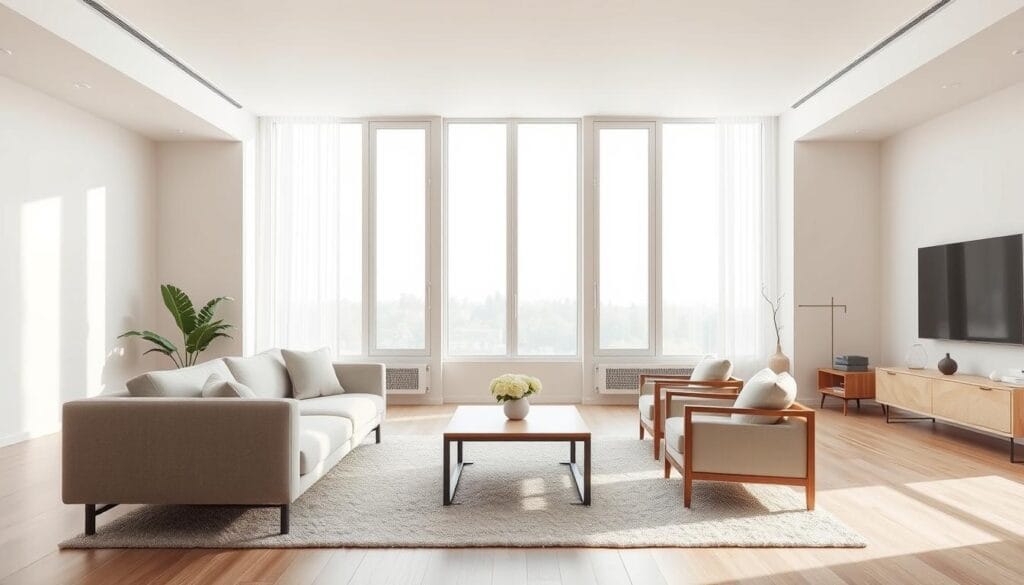
Essential vs. Non-Essential Items
In minimalist design, it’s important to tell what’s needed from what’s not. Essentials should be useful and take up little room. A good couch, a sleek coffee table, and some select accessories can make a big difference. They keep your place warm and welcoming. Non-essentials, on the other hand, just take up space without really adding anything. Go for items with simple lines and storage that you can’t see. This keeps your room feeling big and easy to use. Having fewer things means less to take care of and less stress, proving minimalism is a smart choice.
Lighting in Minimalist Design
Lighting is key in minimalist home design, making the space look clean and open. We’ll look at how the right natural light and simple fixtures can change your space.
Natural Light Optimization
Using natural light well is a big idea in minimalist design. Big windows, skylights, and no walls in between can bring lots of sunlight in. This makes your home bright and welcoming.
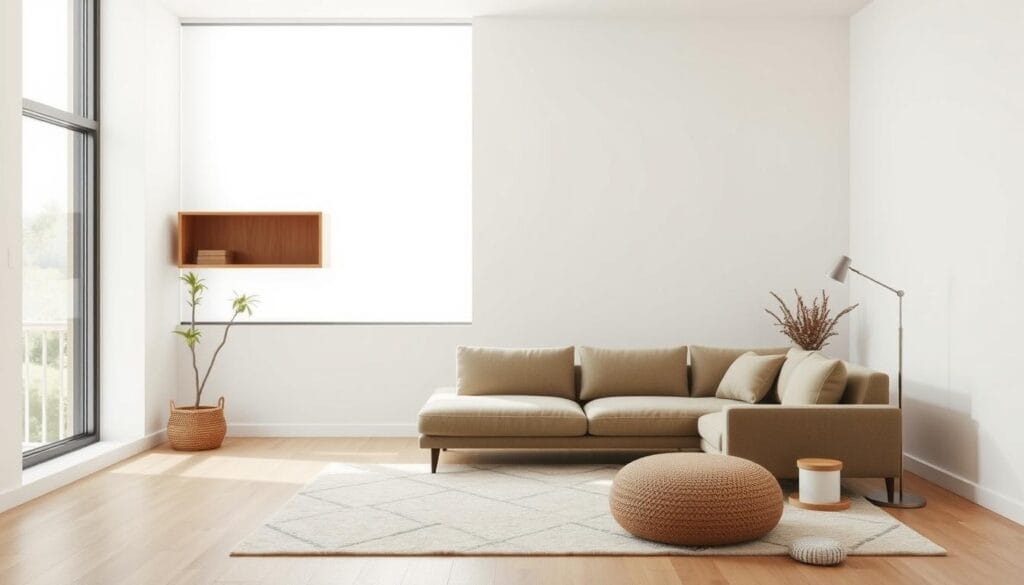
Putting mirrors in the right spots can spread sunlight all over your rooms. This not only lights up your space but also brings a bit of nature inside. It makes your home feel peaceful and connected.
Choosing Simple Lighting Fixtures
When there’s not enough sunlight, minimalist design says to go for simple yet beautiful lights. Choose fixtures that are straightforward and come in basic colors, like black, white, or metal.
Here are some minimalist lighting choices:
- Recessed Lighting: These lights fit into the ceiling and are great for many rooms without being noticed too much.
- Pendant Lights: These are good for anywhere, really stylish and simple, keeping to the minimalist vibe.
- Wall Sconces: Perfect for adding a soft light in halls or bedrooms without taking over the space.
- Semi-Flush Mount Lights: These work well in rooms with regular ceilings and give plenty of light without sticking out too much.
Choosing LEDs is smart because they save energy, last long, and provide great light. Using dimmers lets you change the lighting to suit what you’re doing or how you’re feeling.
Adding these lighting ideas to your minimalist home design will make your place both work better and look nicer.
Textures and Materials to Consider
Textures and materials are very important in modern minimalist design and decor. They help make a space inviting. Mixing different textures stops a space from looking dull. It makes a simple area more interesting. Let’s look at how using natural stuff and the right mix of textures improves minimalist rooms.
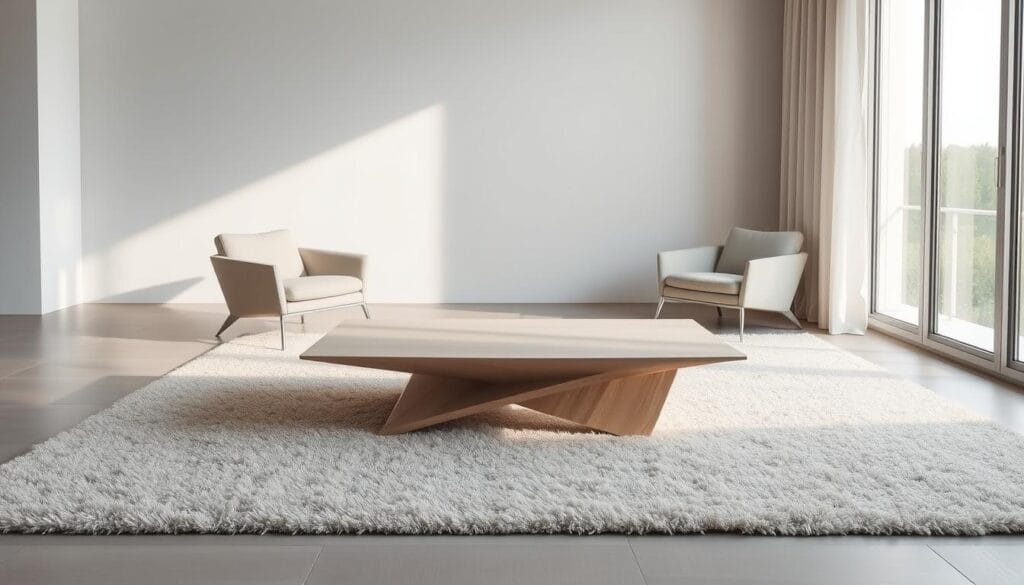
The Role of Natural Materials
Natural materials make minimalist spaces warm and textured. Using wood, stone, and linen is key for a calm and balanced feel. For example, adding wooden touches and stones increases texture. Wall finishes like plaster and using high-pile rugs from wool or silk make the room cozy. These materials are in 65% of minimalist designs. They make your room beautiful and feel good to touch.
Balancing Hard and Soft Textures
It’s important to balance hard and soft textures for a good minimalist design. Designers suggest using wood, marble, steel, and velvet together. Soft materials like boucle and velvet make sofas and chairs comfy. Meanwhile, metal and glass give a sleek look. Adding chunky knit throws and linen bed covers makes it 25% cozier. This careful mix keeps your minimal decor interesting but simple.
Creating an Open Layout
An open layout makes a home feel free and flowing. It leads to better use of space and easy movement. For a calm, tidy look, mix simple home decor with minimalist furniture. Let’s review some space planning tips and zoning tricks for an open layout.
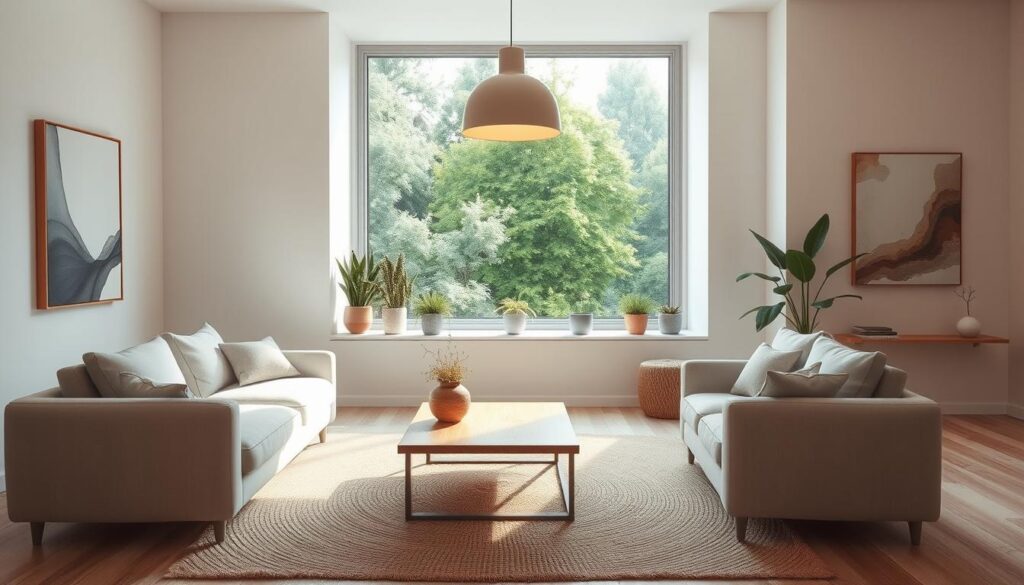
Tips for Space Planning
Starting with a clear plan for each space in your house is key. Set up separate zones for eating, chilling, or work to keep things orderly and efficient. Choose minimalist furniture with extra storage, like expandable tables or ottomans, for both beauty and function.
Cleaning up often brings peace and saves on cleaning time, making more room for fun. Regularly sorting out stuff and buying only what you need prevents messes. This also means choosing well-made items over many, reducing waste and living more sustainably.
Using Zones for Different Functions
You can define areas in an open space without walls. Use soft dividers like rugs or lights. For example, a rug can set apart a sitting area, and hanging lights can spotlight a dining area.
Go for furniture that has more than one use, like benches that offer both seating and storage or shelves that double as dividers. This keeps your space tidy and suits a minimalist vibe. The goal is to combine simple home decor with good organization for a space that’s open and practical.
Another smart move is using sunlight to mark out zones. Homes filled with natural light boost mood, energy, and health. Big windows and few curtains maximize sunlight and its benefits.
Art and Decor in Minimalist Design
In a minimalist living room, “less is more” is our main rule. We pick a few key pieces to make the room interesting and personal, without making it feel busy. Each item has to be meaningful and functional, fitting the room’s look.
Choosing Statement Pieces
Finding the right art and decor is vital in a minimalist space. We go for unique, high-quality items that can stand out on their own. For example, Fintan Whelan’s bold paintings contrast well with simple furniture. Nadia Attura’s photography adds subtle color that fits right in. The art you pick should spark feelings and start conversations.
The Importance of Empty Space
Empty space is key in minimalist design. It highlights each piece’s purpose, making the room feel bigger and open. Studies show that more empty space can make a room seem 30% larger. It’s not just about the physical space. It also brings mental peace and calm.
Try not to fill every empty spot. Instead, use the open areas to show off the art and decor you’ve chosen with care.
Plants and Greenery in Minimalism
Add plants to your minimalist bedroom to make it feel like a calm retreat. Plants make everything feel fresh and lively, without ruining the minimalist look. Picking the right plants can really make your minimalist spaces better.
Selecting Low-Maintenance Plants
Choosing easy-care plants is smart for minimalist bedrooms. Snake Plant, Pothos, and ZZ Plant need little attention but brighten the room. They clean the air by taking away toxins.
Plants can help you feel less stressed, making your home more peaceful. Go for plants like hoya ‘kerri’, black rubber plant, and Fiddle Leaf Fig trees. They grow well in different lights and are easy to care for.
Integrating Nature into Your Space
Adding nature to your minimalist bedroom is more than just putting a plant somewhere. Well-placed plants look great, help you feel better, and keep you connected to nature. A large plant like a Fiddle Leaf Fig can make your room feel bigger and more open.
In small rooms, try hanging plants or plants on the wall to save space. Mix in light colors and natural materials like bamboo for a peaceful room. Use recycled glass for decorations to stay minimalist and help the planet.
For minimalist bedrooms, a little goes a long way. Just a few plants can turn your space into a peaceful haven. You get the beauty of nature with the simple style of minimalism.
Minimalist Kitchen Design Ideas
A minimalist kitchen design focuses on simplicity, functionality, and elegance. These kitchens are beautiful and highly functional. They have a clean, organized look with less clutter. Let’s explore two main features that make a kitchen minimalist.
Streamlined Cabinetry Techniques
Streamlined cabinets are essential for a minimalist look. They lack fancy decorations and might have hidden handles or touch-open tech. This creates a smooth, even appearance. Hidden storage keeps things tidy, and a modern feel is achieved with flat-front cabinets and simple materials like light wood, stone, or polished metal.
Using a neutral color scheme helps make the kitchen feel open. An all-white kitchen is a perfect example of minimalist design, focusing on cleanliness. You can also stack tiles vertically and choose shiny metal finishes for a modern vibe.
Essential Kitchen Tools
In a minimalist kitchen, you only keep necessary tools. Tools that have many uses help avoid clutter. Quality, versatile tools enhance efficiency and contribute to the kitchen’s sleek look. It’s best to have items like a durable chef’s knife, a food processor, and cookware that can do many jobs.
- Robust Chef’s Knife
- Versatile Food Processor
- Multi-use Cookware
Integrated appliances also define minimalist kitchens. They merge with the cabinetry for a smooth look. Examples include built-in fridges, microwaves, and dishwashers.
By applying these cabinetry techniques and choosing essential tools, your kitchen will look and feel minimalist. For more tips on making your home more balanced, read this guide.
Crafting a Minimalist Bedroom Retreat
Creating a minimalist bedroom means focusing on what’s truly needed. With minimalist bedroom design, we create a calm, clutter-free space. This encourages relaxation and well-being. We’ll look into two key parts: the bed setup and the nightstand’s role.
Simplifying Your Bed Setup
The bed is the main focus in any bedroom. In minimalist bedroom design, simplicity is key. Choose a simple frame and a high-quality mattress from brands like Casper or Tuft & Needle. They help improve sleep by 20%.
Use light colors like white and cream to make the room feel bigger, by up to 15%. Beds with built-in storage are very handy. They cut down the need for more storage units by about 30%. Also, lots of minimalists skip heavy curtains for sheer ones or none at all. This choice increases natural light and, with regular cleaning, can lower dust by 40%.
Creating a Functional Nightstand
Nightstands in minimalist home decor mix use with beauty. Pick ones with storage to keep things tidy but close. About 55% of homeowners think function is more important than looks for bedroom furniture. Go for nightstands with simple lines and neutral colors like white, gray, or beige. These colors are preferred by 70% of designers for a peaceful vibe.
Adding plants to your nightstand can boost air quality by up to 50% and bring nature inside. Also, using one main accent color keeps your bedroom looking unified. This is advised by about 50% of minimalist design experts.
DIY Minimalist Interior Design Tips
Start your DIY minimalist home decor with simple projects today! 🎉 Painting a wall neutral, like white or beige, is a good first step. It sets the tone for minimalist design, making any room—from small bathrooms to big bedrooms—feel calm and wide open. You’ll be surprised how a single coat of paint changes the vibe and opens up the space.
Easy Projects to Start With
Beg by clearing out clutter from shelves and counters. Get rid of things you don’t need or use anymore. A tidy space can boost focus and work output by 30%! ☕ For a more active project, try putting up DIY floating shelves. They give you storage without taking up much room, helping keep the space open and simple.
Budget-Friendly Minimalist Upgrades
Going minimalist doesn’t mean spending a lot. Small, affordable changes can have a big impact. Swap out heavy, detailed furniture for lighter, simpler pieces that make rooms seem bigger. Look at IKEA for inexpensive cabinets that light up the room and add to an airy feeling. Painting built-in shelves the same color as your walls can hide clutter and keep your view clean.
Always remember, “less is more.” Pick fewer decorations and functional furniture for a calm, welcoming space. These tips are a great way to begin moving toward simple home decor under minimalist ideas, whether you’re doing a single room or your whole home.


